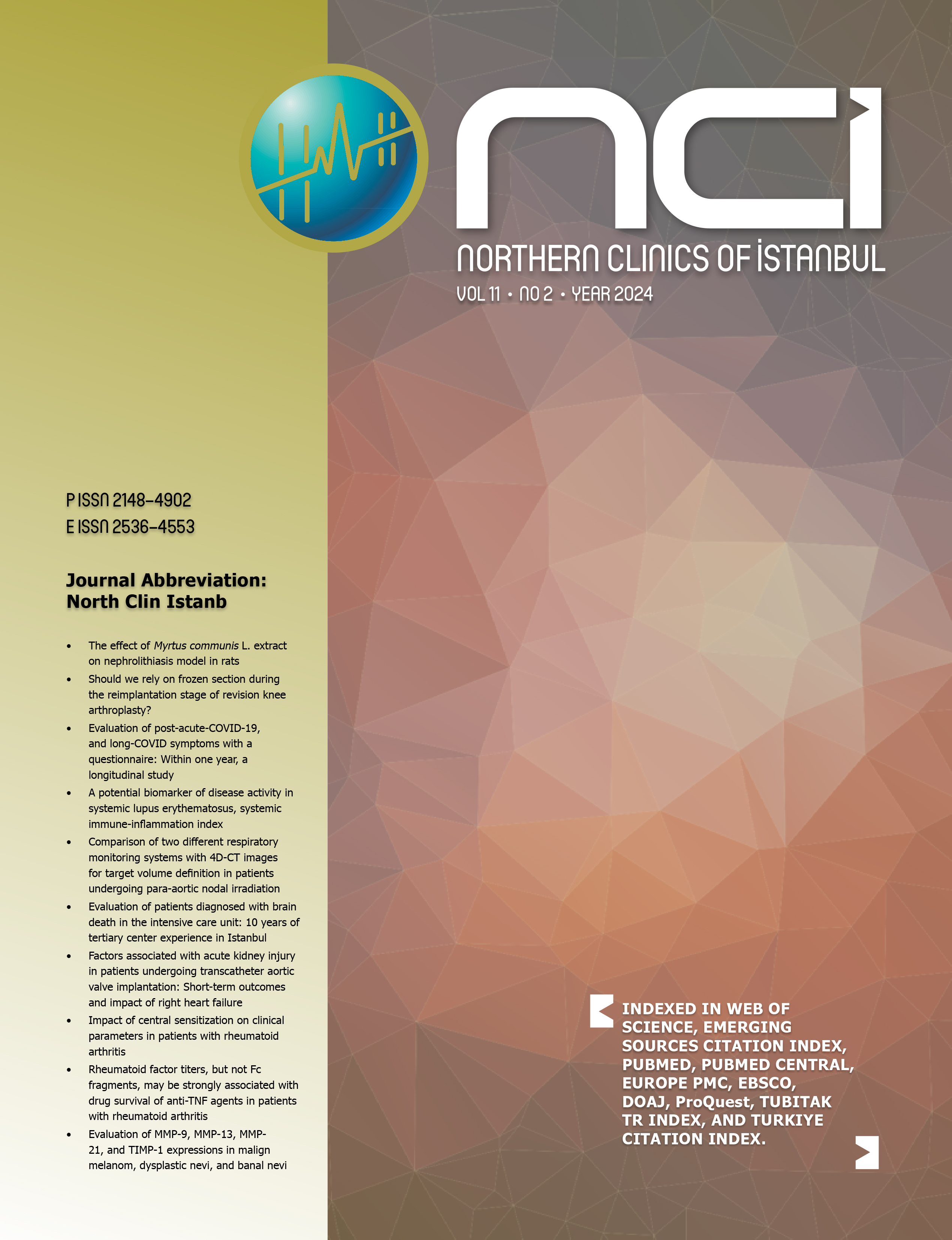Comparison of effects of high and low dose paracetamol treatment and toxicity on brain and liver in rats
Ersoy Oksuz1, Semih Yasar2, Remzi Erten3, Okan Arihan4, Gokhan Oto11Department of Medical Pharmacology, Van Yuzuncu Yil University Faculty of Medicine, Van, Turkey2Department of Medical Laboratory Technics, Van Yuzuncu Yil University Ozalp Vocational High School, Van, Turkey
3Department of Medical Pathology, Van Yuzuncu Yil University Faculty of Medicine, Van, Turkey
4Department of Medical Physiology, Faculty of Medicine Van Yuzuncu Yil University, Van, Turkey
OBJECTIVE: Paracetamol is thought that it acts by inhibiting the central cyclooxygenase (COX) enzyme; its mechanism of action is still not fully explained. Although its most important side effect is hepatoxicity, it is thought to cause toxicity on the brain in recent years. The present study aims to investigate the treatment and toxic effects of low and high doses of paracetamol on the liver and brain.
METHODS: Wistar-albino rats were used in this study. At doses of 20500 mg/kg, paracetamol was administered intraperitoneally once a day for one and three days. The brain and liver were used for immunohistochemical evaluation using COX-3, prostaglandin E2 (PGE2) and caspase 3 antibodies and for total antioxidant (TAS), total oxidant (TOS) and oxidative stress index (OSI) measurements. Results were evaluated using the Kruskal Wallis test (SPSS ver.24).
RESULTS: The liver COX-3 levels were significantly lower in both groups with higher doses (p<0.05). In the brain, there was no statistically significant difference in COX-3 levels between the groups. There was no statistically significant difference in PGE2 levels in the liver and brain between the groups (p>0.05). The caspase 3 level in the liver was statistically significantly higher in the low dose group compared to the other groups (p<0.05). In both liver and brain, OSI values were significantly higher in the 3-day high-dose group compared to others (p<0.05). There was no statistically significant difference between the groups in ALT and AST values (p>0.05).
CONCLUSION: The results of our study show that paracetamol inhibits the COX-3 enzyme in the liver but has no effect in the brain, and COX-3 does not have an effect on PGE2. Paracetamol causes apoptosis in the liver only in low doses; higher doses may cause toxicity by increasing oxidative stress, especially in the brain.
Keywords: Apoptosis, oxidative stress; paracetamol.
Yüksek ve düşük doz parasetamol tedavi ve toksisitesinin sıçan beyin ve karaciğeri üzerindeki etkilerinin karşılaştırılması
Ersoy Oksuz1, Semih Yasar2, Remzi Erten3, Okan Arihan4, Gokhan Oto11Van Yüzüncü Yıl Üniversitesi Tıp Fakültesi, Tıbbi Farmakoloji Anabilim Dalı, Van2Van Yüzüncü Yıl Üniversitesi Özalp Meslek Yüksek Okulu, Tıbbi Laboratuvar Teknikleri Bölümü, Van
3Van Yüzüncü Yıl Üniversitesi Tıp Fakültesi, Tıbbi Patoloji Anabilim Dalı, Van
4Van Yüzüncü Yıl Üniversitesi Tıp Fakültesi, Tıbbi Fizyoloji Anabilim Dalı, Van
Giriş ve Amaç: Parasetamolün, santral siklooksijenaz (COX) enzimini inhibe ederek etki gösterdiği düşünülse de halen etki mekanizması tam olarak açıklanamamıştır. En önemli yan etkisi hepatoksisite olmasına rağmen son yıllarda beyin üzerinde de toksisisteye neden olduğu düşünülmektedir. Bu çalışmada düşük doz ve yüksek doz parasetamolün karaciğer ve beyin üzerinde tedavi ve toksik etkisinin incelenmesi amaçlanmıştır.
Yöntem ve Gereçler: Çalışmada, Wistar-albino sıçanlar kullanıldı. 20 ve 500 mg/kg dozlarında parasetamol 1 ve 3 gün boyunca günde bir defa olmak üzere intraperitoneal olarak verildi. Son dozlar verildikten 24 saat sonra sıçanlar sakrifiye edilerek kan örnekleri, beyin ve karaciğerleri alındı. Beyin ve karaciğer, COX-3, PGE2 ve caspase 3 antikorları kullanılarak immunuhistokimyasal değerlendirilmede ve TAS, TOS, OSI ölçümlerinde kullanıldı. Kan örneklerinden ticari kit kullanılarak ALT ve AST düzeyleri tespit edildi. Sonuçlar kruskal Wallis testi ile (SPSS ver.24) değerlendirildi.
Bulgular: Karaciğerdeki COX-3 düzeyi yüksek doz uygulanan her iki grupta diğerlerine göre istatiksel anlamlı olarak düşüktü (P<0.05). Beyinde ise COX-3 düzeyinde gruplar arasında istatiksel anlamlı bir fark yoktu. Karaciğerde ve beyindeki PGE2 düzeyinde gruplar arasında istatiksel anlamlı bir fark yoktu (P>0.05). Karaciğerdeki caspase 3 düzeyi sadece düşük doz uygulanan grupta diğer gruplara göre istatiksel anlamlı olarak yüksekti (P<0.05). Beyinde ise caspase 3 düzeyinde gruplar arasında istatiksel anlamlı bir fark yoktu (P>0.05). Hem karaciğerde hemde beyinde sadece 3 gün yüksek doz gruptaki OSİ değeri 3 gün yüksek doz grupta diğerlerine göre anlamlı yüksek bulundu (p<0.05). ALT ve AST değerlerinde gruplar arasında istatiksel anlamlı bir fark yoktu (P>0.05).
Tartışma ve Sonuç: Çalışmamızın sonuçları, parasetamolün karaciğerde COX-3 enzimini inhibe ettiğini fakat beyindeki COX-3ün düzeyi üzerinde herhangi bir etkisinin olmadığını, COX-3 enziminin PGE2 üretimi üzerinde herhangi bir etkisinin olmadığını göstermektedir. Ayrıca bu sonuçlar, parasetamolün düşük dozlarda sadece karaciğerde apoptoza neden olduğunu yüksek dozlarda ise beyinde daha fazla olmak üzere oksidatif stresi artırarak toksisiteye neden olabileceğini göstermektedir. (NCI-2020-0027.R1)
Anahtar Kelimeler: Parasetamol, apoptoz, oksidatif stres
Manuscript Language: English





















